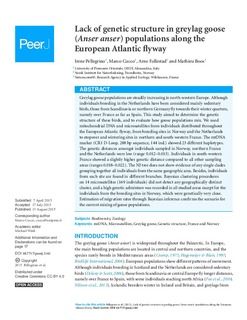| dc.description.abstract | Greylag goose populations are steadily increasing in north-western Europe. Although
individuals breeding in the Netherlands have been considered mainly sedentary
birds, those fromScandinavia or northern Germany fly towards their winter quarters,
namely over France as far as Spain. This study aimed to determine the genetic
structure of these birds, and to evaluate how goose populations mix. We used
mitochondrial DNA and microsatellites from individuals distributed throughout
the European Atlantic flyway, from breeding sites in Norway and the Netherlands
to stopover and wintering sites in northern and south-western France. The mtDNA
marker (CR1 D-Loop, 288 bp sequence, 144 ind.) showed 23 different haplotypes.
The genetic distances amongst individuals sampled in Norway, northern France
and the Netherlands were low (range 0.012–0.013). Individuals in south-western
France showed a slightly higher genetic distance compared to all other sampling
areas (ranges 0.018–0.022). The NJ tree does not show evidence of any single clades
grouping together all individuals fromthe same geographic area. Besides, individuals
from each site are found in different branches. Bayesian clustering procedures
on 14 microsatellites (169 individuals) did not detect any geographically distinct
cluster, and a high genetic admixture was recorded in all studied areas except for the
individuals from the breeding sites in Norway, which were genetically very close.
Estimation of migration rates through Bayesian inference confirms the scenario for
the current mixing of goose populations.
Subjects Biodiversity, Zoology
Keywords mtDNA, Microsatellites, Greylag goose, Genetic structure, France and Norway | nb_NO |

